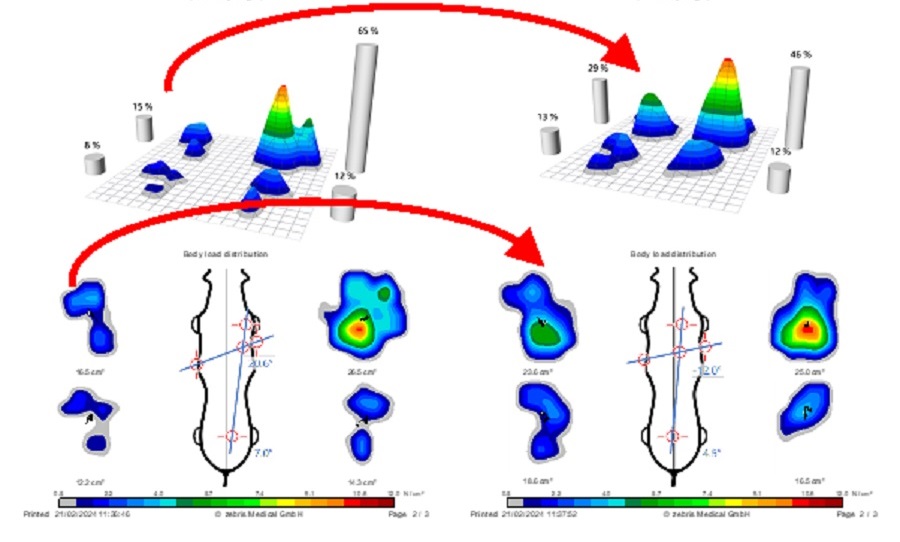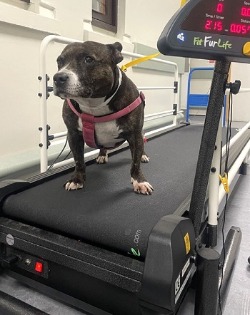Latest In Gait Assessment Technology with the Orthopaedic Service
Clinical Connections – Spring 2024
Richard Meeson, Professor of Orthopaedics and Head of the Orthopaedic Service
Recently, thanks to the kind generosity of the Animal Care Trust (ACT), the RVC’s registered charity, a grant was awarded to upgrade the now out of date pressure mat, to allow the team to expand their lameness diagnosis and clinical monitoring through a state-of-the-art instrumented dog treadmill.
The treadmill is similar to that used by humans in gyms, however this one blends a state-of- the-art matrix of tiny pressure sensors. A computer then matches the pressure sensor activation to the correct foot, from the synchronised cameras filming as the dog walks.
Technology constantly develops and this new instrumented treadmill is able to provide instant data on the characteristics of how the dog is using its legs. Previously, data retrieval had been complicated and time consuming, preventing it from being a routine ‘bedside’ clinical aid. Additionally, it produces graphical ‘heat-map’ pictures with a simple overview summary which can be provided to clients (Figure 2).
Objective evaluation
Evaluating ‘how well’ a dog is walking by observing them walking has been proved to be very unreliable, unless they are completely normal or severely affected. Many dogs seen for lameness are between the two and therefore a more reliable and non-biased way to measure how well they’re walking is extremely important for research and for monitoring response to treatment.
Over the last 10 years, the Queen Mother Hospital for Animals has used a flat pressure-mat, which measures the pressure from each paw as a dog walks across it. Technology and the computer’s software have improved greatly since then and a further development was to combine this with a treadmill. For the first time, it is possible to have a dog walking consistently without ‘running out of runway’ and to evaluate them at faster speeds, such as a trot.
For dogs that are not very mobile, it will even give a standing evaluation of how much of their body weight they are placing on each limb when standing.

Jerry’s RVC treadmill story

Jerry is a 10-year-old Staffordshire bull terrier, who was initially referred to the Neurology and Neurosurgery Service with a three-week history of progressive left forelimb lameness. He had a complex history, including a previous thoracolumbar disc extrusions and myelopathy.
After examination, it was determined that his lameness was not neurological and he was assessed by the Orthopaedics Service. It was clear that he was lame on his left forelimb, but he was extremely stoic, preventing more accurate localisation, and diagnostic CT found arthritis in his elbow and carpus.
Jerry was evaluated on the treadmill, which confirmed his left forelimb lameness. Afterwards he had a local anaesthetic injection to ‘block’ his elbow and, on repeated treadmill evaluation, his lameness was significantly improved. This allowed the team to focus treatment on his elbow joint, and he has made great progress since.
Difficult to identify lameness, or subtle performance changes, can now be objectively evaluated. Likewise chronic pain conditions, typically seen by the Anaesthesia and Analgesia Service bespoke Pain Clinic, will have static measurements taken to monitor responses to their treatments.
Furthermore, with this new pressure mat, the Orthopaedic Service will be continuing to contribute and expand their clinical research to provide evidenced-based objective understanding of dogs with orthopaedic conditions and the impact of treatments and surgery.
The Orthopaedic Service at RVC Small Animal Referrals is one of the largest teams in Europe, currently with eight surgeons (six European Diploma holders/RCVS Recognised Specialists), including Head of Service Richard Meeson, Deputy Head of Service, Rebekah Knight, Senior Orthopaedic Surgeon Matthew Pead, and faculty surgeons Anna Frykfors, Rhiannon Strickland, Carlos Sanchez, Matthew Simpson and Charlotte Banks. They work with three Specialist Orthopaedic Service RVNs – Kate Fitton, Emily Few, Nancy Mclaughlin. Additionally, there are six surgical residents.
